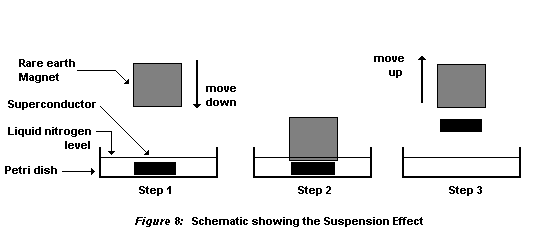The levitation of a magnet above a superconductor, the Meissner Effect, is well known. In October 1988, Huang and Peters of Lockheed and NASA respectively announced a startling and almost accidental discovery that they had made while investigating high temperature ceramic superconductors. This suspension phenomena can be demonstrated with the help of the Suspension & Levitation Kit from Colorado Superconductor Inc.
The Kit contains a special superconductor disk which we shall call the Enhanced Flux Pinning (EFP) disk. A large, powerful neodymium rare earth magnet has been provided to suspend the EFP disk. A parallel set of materials have also been provided with the Kit to demonstrate the Meissner Effect for comparison. The experimenter requires only a source of liquid nitrogen for this experiment.
Procedure
- ACTION
Completely immerse the EFP disk in a flat dish containing liquid nitrogen. The styrofoam dish in your Kit's container will do adequately.
RESULT
The liquid nitrogen boils around the EFP disk. When the boiling subsides, proceed. - ACTION
Examine the large neodymium magnet, and mark the square face with ink. This is the face through which the magnetic axis passes. - ACTION
Holding the magnet with the provided non-magnetic tweezers such that the magnetic axis is vertical, slowly lower the magnet so that it just touches the top of the immersed EFP disk.
RESULT
As the magnet approaches the EFP disk, there will be a momentary resistance to its continued downward motion. This will cease when the magnet is in contact with the EFP disk. This resistance is a manifestation of the well-known Meissner Effect. - ACTION
Gradually withdraw the magnet upwards.
RESULT
The EFP disk should follow the magnet as it moves upwards and out of the liquid nitrogen. Observe that there is a gap between the EFP disk and the magnet. This is a gap that one would not observe in normal magnetic attraction.
RESULT
As the EFP disk warms, it will loose its superconductivity, and can no longer be suspended under the magnet. It will drop.
This was a demonstration of the Suspension Effect in the new high temperature ceramic superconductors. Figure 8 below illustrates the salient features of this demonstration.
Precautions
- The EFP disk is particularly sensitive to moisture. Please dry the disk immediately after use.
- The large neodymium rare earth magnet is very brittle. This powerful magnet will abruptly adhere to ferromagnetic materials, or to the small neodymium magnet provided with kit. This impact can easily chip or shatter the magnet(s).
- The EFP disk may shatter if it falls on a hard surface after the Suspension effect ceases. Please take care to suspend the disk over a soft surface, or over the liquid nitrogen bath.
- The EFP disk is very cold. Do not attempt to handle it when it has been withdrawn out of the liquid nitrogen bath. Also, do not attempt to catch it in your hand when it falls when suspension ceases.
Some Questions
- Can you think of any way that the Suspension Effect can be prolonged?
- Why do you think that the Suspension Effect was not observed with the low temperature superconductors of yesteryear?
- What are some potential applications of the Suspension Effect?
The EFP disk was fabricated using a different temperature cycle than that used for making the normal superconductor disks. The EFP disk can also be made by doping (alloying) the regular superconductor disk with a small amount of silver metal.
The Meissner Effect cannot be used to explain the Suspension Effect. Several alternative explanations have been advanced to explain this phenomena. One such explanation invokes the pinning of magnetic flux lines by the superconductor (hence our name, the Enhanced Flux Pinning disk). The magnetic field flux lines are pinned to impurities or imperfections within the superconductor, and they thus prevent the superconductor from moving in any direction relative to the flux lines.

Information Courtesy of CSI Superconductors

